

4/4/06
Edition
A BROOKS DAY ON DVD!
Fox's Eight-Film DVD Box Set Gives Us
The Best Of Mel
Plus:
'80s FLASHBACK with KNOTS LANDING, KONG and More!
Having grown up on the movies of Mel Brooks and Gene Wilder, I’m
thrilled to report that major DVD omissions in the filmographies of
both talents have been rectified this week thanks to Fox.
The superlative, eight-film anthology THE MEL BROOKS
COLLECTION -- out this Tuesday -- houses Brooks’ entire
output with Fox (“Young Frankenstein,” “Silent
Movie,” “High Anxiety,” “History of the World
Part I,” “To Be Or Not To Be” and “Robin Hood:
Men In Tights”), with the addition of “The Twelve
Chairs” and “Blazing Saddles,” the latter on loan
from Warner Bros.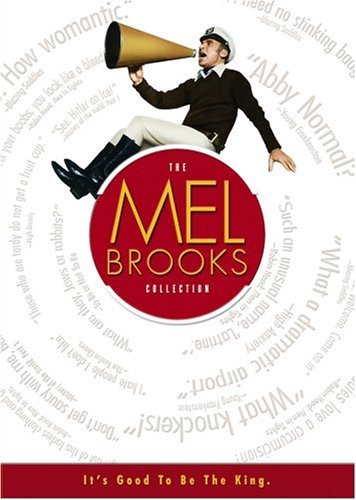
Four of the films in Fox’s collection have never been released
before, while several have been upgraded from previous editions --
making this release absolutely essential for any Brooks fan.
Brooks’ early THE TWELVE CHAIRS (**½, 93 mins., G, 1970)
is a surprisingly restrained adaptation of a 1920s Russian folk tale,
with Brooks starring alongside Ron Moody, Dom DeLuise and Frank
Langella. The movie has its admirers though I’ve never been a
huge fan of the picture, which is presented in a generally satisfying
16:9 presentation on DVD here (Image's inferior 2000 DVD has been out
of print for some time) alongside his later
‘70s work for Fox. Those latter, generally under-rated efforts
range from the delightful 1976 SILENT MOVIE (***, 87 mins., 1976, PG)
to the intermittently uproarious Hitchcock spoof HIGH ANXIETY (***,
1977, 94 mins., PG), complete with one of Brooks’ more memorable
collaborations with composer John Morris (memo to those reading from
various record labels: isn’t it time a proper retrospective of
Brooks’ and Morris’ film music be released on CD at long
last?).
Brooks’ HISTORY OF THE WORLD: PART I (**, 92 mins., 1981, R) was
one of the director’s few flicks I couldn’t watch as a kid
(due to its R rating), but I wasn’t missing much, as this
rambling and often unfunny farce has one inspired, five-minute
musicalization of the Spanish Inquisition (presumably a warm-up for
Brooks’ later “Producers” musical), but precious
little else to recommend it. Thankfully, Brooks returned to form in
1983's TO BE OR NOT TO BE (***, 1983, 107 mins., PG), a collaboration
with wife Anne Bancroft that fueled an engaging remake of the Ernest
Lubitsch early ‘40s classic.
As the ‘80s wore on, Brooks’ directing output dried up,
with the mediocre “Spaceballs” followed by the even-worse
“Life Stinks” -- a major stinker indeed for MGM, the latter
grossing a paltry $4 million total in its domestic run.
Thankfully, Brooks reverted to at least respectable form with the
generally under-rated 1993 parody ROBIN HOOD: MEN IN TIGHTS
(**½, 104 mins., PG-13, 1993) which incredibly makes its DVD
debut here for the first time in the U.S. A mix of Brooks veterans
(Dick Van Patten, Dom DeLuise) works with a game assortment of younger
comedians (Richard Lewis, Tracy Ullmann, and even Dave Chappelle) for
this predictable, slightly overlong, but nevertheless amusing
assortment of gags primarily aimed at ribbing 1991's Kevin Costner
blockbuster. Even Hummie Mann’s score is decent (the love theme
being surprisingly sweet), though I still wonder even now why
Brooks’ relationship with John Morris terminated as abruptly as
it did.
Those six films have been newly remastered by Fox for this DVD
collection (“History” was previously available in a
non-anamorphic DVD that’s been out of print; the new DVD is
16:9), and the good news is that the older Special Edition contents of
Brooks’ classic YOUNG FRANKENSTEIN (****, 102 mins., 1974, PG)
have been reprieved here, with the added bonus of seeing the movie in
16:9 widescreen for the first time.
The lone disappointment in “The Mel Brooks Collection” is
that BLAZING SADDLES (***½, 93 mins., 1974, R) is presented in
Warner’s initial 1997 DVD release, with an early (and quite
mediocre by today’s standards) DVD transfer that was markedly
improved upon in the studio’s 30th Anniversary Special Edition in
2004.
With the exception of “Young Frankenstein,” supplements are
sparse on the new discs: just trailers and the occasional Making Of
featurette (on “To Be Or Not To Be” and “Robin Hood:
Men In Tights”) pop up on the respective titles, though the Dolby
Digital stereo and mono tracks are in good condition and the 16:9
transfers solid across the board (with the exception of the ancient
“Blazing Saddles” transfer). Each film is contained in a
slim-line case with its own packaging, and viewers should note that
none of the new titles debuting in this set are available separately.
Through “Young Frankenstein” and “Blazing
Saddles,” Brooks’ two movies met with widespread acclaim
and humongous box-office returns in 1974. While one can say that
Brooks’ post-1974 career had some bright spots (his Tony-winning
“Producers” musical obviously being one of them), never
again did the comedian-actor-filmmaker approach the zenith of his
one-two cinematic punch that year.
One could point to “Saddles” and “Frankenstein”
star/co-writer Gene Wilder’s decision to go off on his own and
produce his own comedies as a pivotal turning point in the careers of
both talents, with two of Wilder’s curious, post-Brooks projects
just hitting video for the first time this week.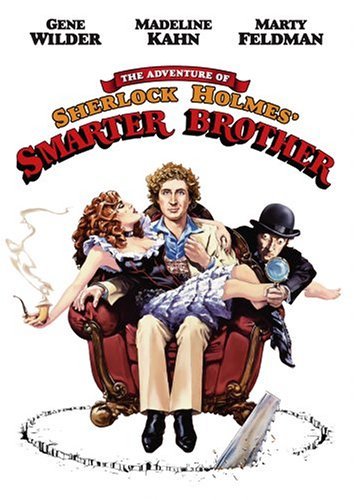
Wilder worked with his “Young Frankenstein” co-stars
Madeline Kahn and Marty Feldman in the highly uneven THE ADVENTURE OF
SHERLOCK HOLMES’ SMARTER BROTHER (**½, 1975, 91 mins., PG),
with Wilder directing, writing and starring as Sigerson Holmes in a
Brooks-ian, slapstick romp with a pleasant score by John Morris and
amusing supporting turns from Dom DeLuise and Leo McKern. The movie,
though, is all over the map, with a few big laughs off-set by long
stretches of tedium that even the most-die hard Wilder fan may have a
hard time overlooking.
After hitting paydirt with “Silver Streak” in ‘76,
Wilder tried his hand at directing one more time with THE WORLD’S
GREATEST LOVER (***, 89 mins., 1977, PG), a valentine to the
silent movie era with Wilder heading west to enter a talent search for
the next Rudolph Valentino. Carol Kane’s amusing performance as
Wilder’s shy wife makes this humorous and even poignant film good
fun, and at least it’s superior to the star’s later efforts
behind the camera: the entertaining, though uneven, 1984 comedy
“The Woman In Red” and less-said-the-better 1986 bomb
“Haunted Honeymoon.”
Fox’s individual DVD releases of the two Wilder comedies offer
both 16:9 widescreen (1.85) and full-screen transfers, plus enjoyable
commentary tracks from Wilder. The star wistfully recalls working on
both movies, and is particularly enlightening when he discusses how
Hollywood no longer has room for the kinds of fun, warm-hearted
pictures both he and Brooks turned out in the ‘70s and
‘80s.
Comments like those provide an honest, bittersweet cap to a wonderful
assortment of comedic gems Fox has mined this week on DVD. Bravo!
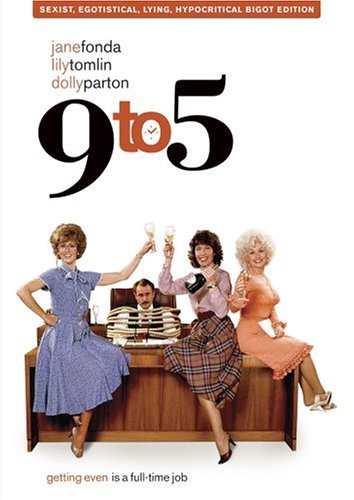 More Aisle Seat Vintage
More Aisle Seat Vintage
Also worth nothing from Fox is this week’s Special Edition of the
1980 comedy NINE
TO FIVE (***, 109 mins., 1980, PG), Colin Higgins’
feminine empowerment fantasy about three office workers (Jane Fonda,
Dolly Parton, Lily Tomlin) who decide to give obnoxious boss Dabney
Coleman a taste of his own medicine.
Higgins and Patricia Resnick’s script has the feel of a sitcom
from the era, with some slapstick laughs mixed into its satiric brew
(gotta love the animation when Tomlin dons the Snow White outfit), but
its point -- even if it’s an obvious one -- was well taken and
certainly devoured by audiences, who helped the movie gross over $100
million (a large lump of cash in those days) and become one of the top
hits of 1980.
Fox’s Special Edition DVD is a keeper, featuring a half-hour
documentary that incorporates new interviews with all the stars and
producer Bruce Gilbert; an engaging commentary track with the three
leading ladies and Gilbert; a featurette remembering Higgins; 10
deleted scenes, running over 10 minutes, with additional animation from
the Snow White sequence; a gag reel culled from a video tape source; a
karaoke sing-along version of Parton’s theme song; and the
original trailer, sporting Leroy Anderson’s vintage
“Typewriter” composition. The 16:9 transfer is good, but
the movie has that “plastic” look many films of its time
possess. On the audio side, the “expanded” 2.0 Dolby Stereo
track has the edge on the original mono mix, which is also included.
KING KONG
(**½, 2005). 188 mins., PG-13, Universal. DVD SPECIAL FEATURES:
Post-Production Diaries (comprehensive documentary); “Skull
Island: A Natural History” and “Kong’s New York,
1933" featurettes; 2.35 (16:9) Widescreen, 5.1 Dolby Digital sound.
Growing up in the ‘80s, I became a huge “King Kong”
fan through repeated viewings of both the original 1933 RKO classic and
its less-dignified, though still entertaining, 1976 remake. In between
those decades, Kong resurfaced in a silly Rankin/Bass cartoon and an
affiliated Toho Studios Japanese “Kaiju” spin-off -- not to
mention his immortal battle with Godzilla in the early ‘60s.
Therefore, I had no problem at all with Peter Jackson remaking
“King Kong” for a new generation -- especially not when you
see the loving care that Jackson applied to the remake: references to
Fay Wray, Marian C. Cooper and RKO Pictures pop up early on. Later in
the movie, Max Steiner’s original ‘33 themes are performed
by the pit orchestra as Kong is introduced to the city of New York
(conducted by Howard Shore, whose original score to this version was
tossed out at the last minute), while the goofy tribal dance from the
Cooper-Schoedsack classic is reprised by dancers on-stage. The end
credits even appear against a backdrop with the 1933 title card fonts
-- elements all respectful of the filmmaking milestone that was the
very first “King Kong.”
Naturally, Jackson’s movie has the benefit of new technology
behind it: this is a film packed with visual delights, from the
authentic recreation of Depression-era NYC, to the amazing animation
and “performance” of Kong himself. Articulated to a degree
by Andy Serkis (Jackson’s Gollum cohort) and marvelously rendered
on-screen, this is a Kong that’s a far cry from the stilted Rick
Baker suit in Dino DeLaurentiis’ 1976 remake and ranks with the
most awe-inspiring technological achievements that special effects
wizards have produced throughout the decades.
So, there’s no problem at all with Jackson’s new film,
right? A remake respectful of its predecessor with sensational visuals
ought to be something to be admired and savored for generations to
come, no?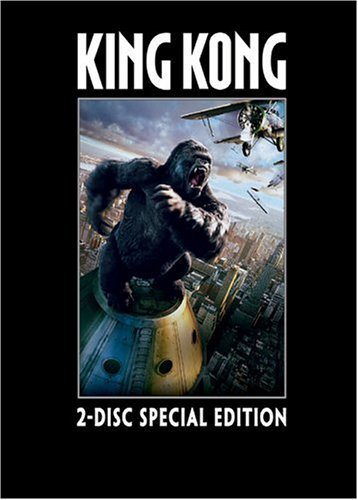
Sadly, not everything in Jackson’s sprawling, overlong,
three-hour (!) opus matches its good intentions and aesthetic
qualities. This is a movie that plays like the kind of
“Director’s Cut” studios indulge filmmakers on DVD,
bulging with superfluous details and side characters with no pay-off,
and scene after scene that could have been sliced in half and been
every bit as effective -- if not more so for their brevity.
Since the original movie’s premise needs little introduction,
it’s best to dissect the alterations Jackson and his
collaborators (writers Fran Walsh and Philippa Boyens) have applied to
this version. Here, leading man Jack Driscoll (Adrien Brody) is a
playwright suckered into one of director Carl Denham’s latest
productions. Ann Darrow (Naomi Watts) is a down-on-her-luck actress
seeking a way out of the Depression, and finds the opportunity of a
lifetime despite the suspicious motives of Denham himself. All three,
and a crew led by captain Thomas Kretschmann, find themselves on Skull
Island, a prehistoric environment teeming with dinosaurs, giant
insects, wild natives and one giant ape named Kong...
One of the first things you’ll realize about Jackson’s
“King Kong” is that -- after a marvelous beginning in an
early ‘30s Big Apple -- the film chugs along at a snail’s
pace. The journey to Skull Island finds Jackson spending minute after
minute on extraneous side characters and details; unlike his
“Lord of the Rings” adaptations, though, the source
material here doesn’t beg for a three-hour treatment, with one
especially infuriating subplot involving Jamie Bell’s young
seaman and his older, wiser superior (Evan Parke). Their relationship
doesn’t add anything to the finished film, and could have been
jettisoned without any detriment to the central drama.
Over a third of the movie is over before Kong appears, and naturally
there are several “jackpot” set-pieces, including a
brontosaurus stampede and a chase with raptors (and later, a pair of
T-Rexes) not far behind. Regrettably, the movie then stalls out again
with sequences that run on too long: the “spider pit” scene
in particular is especially bloated (and atrociously spotted with
inappropriate music from a mostly subdued, ultimately forgettable James
Newton Howard soundtrack). Eventually, Jackson gets Ann, Jack and
Denham off the island and back to New York, but even there, every scene
feels several beats off-measure: the icy jaunt through Central Park
with Ann and Kong is cute but ought to be over in half the time, and
even the final battle on top of the Empire State Building (which
Jackson wisely refrains from being overly bloody) leaves you feeling
like you’ve watched each and every fly-over of the bi-planes that
eventually take Kong down.
Between the bloated running time, over-reliance on side details and
minor characters, what one is left with in “King Kong” is a
film where the viewer ultimately has little interest in its heroes.
Watts looks fetching and is effectively emotive in her encounters with
the big ape, yet her scenes with Brody’s Jack are confined to the
first third of the movie -- something that detracts from any real
chemistry between the two. Brody himself looks as if he could have made
for a perfect “everyman” kind of hero, but the script
doesn’t give him nearly enough to do. Worst of all is Jack
Black’s Denham: the movie clearly didn’t want to make him
into the nefarious bad guy that Charles Grodin served up in the
‘76 version, and subsequently balances out some of the
character’s despicable behavior with comedic elements. Yet,
he’s still unhinged, and the film ultimately doesn’t come
down hard enough on him: his reading of the movie’s final line
rings false because it’s still Denham in this version who’s
truly responsible for the tragedy of the final act.
By the time the would-be heart-tugging climax arrives, I felt more
exhausted than moved by the 2005 “King Kong.” This is a
reverent and beautifully-made picture that nevertheless wears you down:
after all the running, shooting, shaking camera and muddled
characterizations, it becomes apparent that Jackson’s movie left
its heart somewhere between here and Skull Island.
That all being said, Universal still serves up a DVD that’s
magnificent to behold. The 16:9 transfer and 5.1 Dolby Digital
soundtrack are each reference quality, and the second disc (in the
Special Edition package) houses a pair of featurettes and -- more
importantly -- additional hours of Jackson’s superlative
“Production Diaries”, this time focusing on the
post-production and release of his epic film. There’s no question
that a great deal of time, energy and money was spent on the picture,
and as these vignettes attest, Jackson truly does care about not just
about his work but also with providing the viewer with an enlightening
look behind at the scenes at the filmmaking process. Together with the
excellent “King Kong Production Diaries” DVD package from
last December (not to mention his “Lord of the Rings” and
“Frighteners” Special Editions), this DVD further adds to
the filmmaker’s legacy of providing rich DVD supplemental content
for viewers of all ages.
Hopefully, for the inevitable re-cut of the film we’ll
undoubtedly see on DVD one day, Jackson will trim his ragged, overlong
beast of a theatrical cut and find the tighter, more satisfying film
that possibly lurks inside.
TV on DVD
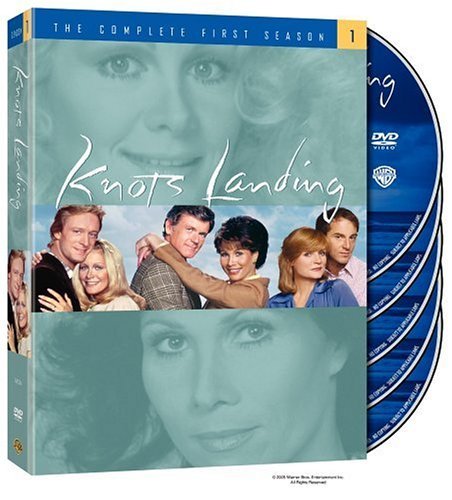 As I wrote earlier, growing up in the ‘80s, I
wasn’t the target audience for night-time soaps like
“Dallas,” “Dynasty,” and KNOTS LANDING,
which last week hit DVD for the first time. However, having checked out
Warner’s new box set (1979-80, 13
episodes, 694 mins.) and recently watched “Desperate
Housewives” copy (but not improve upon) the formula established
by “Knots” for prime-time soap opera fun, I can firmly say
this series is every bit as entertaining as its reputation among fans
would lead you to believe.
As I wrote earlier, growing up in the ‘80s, I
wasn’t the target audience for night-time soaps like
“Dallas,” “Dynasty,” and KNOTS LANDING,
which last week hit DVD for the first time. However, having checked out
Warner’s new box set (1979-80, 13
episodes, 694 mins.) and recently watched “Desperate
Housewives” copy (but not improve upon) the formula established
by “Knots” for prime-time soap opera fun, I can firmly say
this series is every bit as entertaining as its reputation among fans
would lead you to believe.
“Knots Landing” began as a spin-off of “Dallas”
but ended as the most enduring show of its entire genre, surpassing its
peers in terms of number of episodes produced (13 seasons) and --
perhaps more significantly -- earning more critical kudos along the way
for its comparatively “realistic” story lines than the
shenanigans with J.R. and Joan Collins found elsewhere on the dial.
From what I’ve read, things on the series heated up later on (the
show apparently hit its stride once William Devane joined the cast),
but there’s still sufficient amusement to be found once Gary
Ewing (the appropriately bland Ted Shackleford) moves to a lovely
California cul-de-sac with wife Valene (Joan Van Ark, who I remembered
more as a kid for her vocal performance as “Spider-Woman”).
Turns out not everything in Knots Landing is as squeaky clean as you
might imagine -- indeed, once neighboring Don Murray’s daughter
(Karen Allen!) shows up drunk and raises hell, it’s clear Gary
and Val will soon plunge head-first into the sorts of melodrama that
only a glossy CBS prime-time soap from the late ‘70s and
‘80s can provide.
Jerrod Immel’s infectious, unforgettable theme music sets the
viewer up perfectly in the pilot for the entertainment that the 13
first-season “Knots Landing” episodes provide: though
there’s a definite “Dallas” feel to the early shows
(no surprise with cameos by Larry Hagman and Patrick Duffy on-hand),
it’s not long before the series’ more laid back,
family-oriented domestic drama falls comfortably into a formula that
would remain intact until the show went off the air in 1993.
Warner’s four-disc box set offers commentary from Van Ark and
Shackelford on two episodes, including the pilot, plus an interview
segment with the stars reflecting on their long run on “Knots
Landing.” Transfers are in good condition and the mono sound
rings through loud and clear, with Immel’s mellow, jazzy score
providing a perfect backing for the sometimes over-the-top, but always
amusing, goings-on in Knots Landing.
Also newly available is the Sixth Season of THREE’S
COMPANY (1981-82, 28 episodes, 650 minutes, Anchor Bay), which
has arrived on DVD in another superlative package courtesy of Anchor
Bay.
With Suzanne Somers gone and Jenilee Harrison only providing a
serviceable fill-in for Chrissy Snow, the producers wisely added
smarter, sexier Priscilla Barnes to the mix as Terri Alden, new
roommate to John Ritter’s Jack and Joyce DeWitt’s Janet.
Barnes was a superb addition to the show, eschewing the “dumb
blonde” stereotype and enhancing the series’ 28
sixth-season episodes, which seem a lot more energetic and focused than
the previous year. Whether that’s due to the off-set issues
involving Somers having cleared up, or Barnes providing more robust
comedic opportunities than Harrison’s character afforded,
it’s easy to see from Anchor Bay’s four-disc DVD set why
fans regard the sixth year of “Three’s Company” as
one of the best.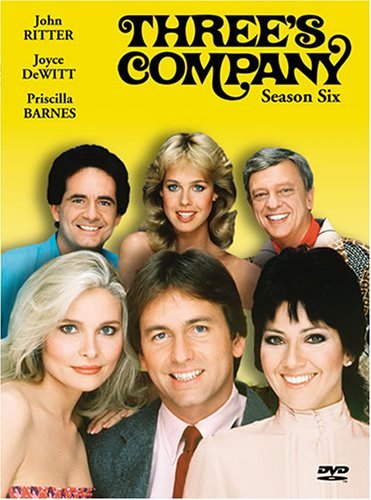
As with Anchor Bay’s previous DVD box sets, the 28 sixth-season
episodes are presented in uncut, satisfying transfers with commentary
on the premiere episode from series director Dave Powers. Excerpts from
a Polish dubbed episode are on-hand, along with a vintage 1982 one-hour
clip special, “The Best of Three’s Company,” which
nabbed Lucille Ball as host for a standard retrospective we rarely see
on network TV these days. Liner notes from producer George Sunga put
the finishing touches on another stellar sitcom package for
“Three’s Company” fans.
Comedy is a subjective business, and that statement is made
particularly true by Paramount’s release this week of THE ANDY MILONAKIS
SHOW: The Complete First Season (2005, 160 mins.; Paramount).
Milonakis acts like a teenager on this series of comedic bits (you
can’t even call them sketches) that are, keep in mind, aimed at
teenagers. This MTV2 show is an acquired taste to be sure, and a little
of the half-hour series tends to go a long way: whether he’s
insulting elderly folks, causing havoc as he interviews pedestrians, or
meeting celebs like Snoop Dogg and the Black Eyed Peas, Milonakis
displays a poker face as he acts like an idiot in an effort to get
laughs any way he can. To be fair, I laughed a bit here and there
(especially in bits involving John Stamos and Rob Schneider), but taken
as a whole this is the kind of show you absolutely need to sample
before considering a purchase...or perhaps even a rental.
Paramount’s two-disc set includes the first season’s eight
episodes in full-screen transfers with Dolby Digital 2.0 sound. Extras
are ample, including unaired “skits,” extended scenes,
outtakes, interviews, and commentary from the cast and critic Richard
Huff, who hated the show and was invited to participate in the DVD. Go
figure!
The Latest Horrors
& Monsters on DVD
Last year I interviewed John Landis about his career, and the veteran
filmmaker proudly boasted about the cable-DVD anthology series
“Masters of Horror,” which he was directing an episode of.
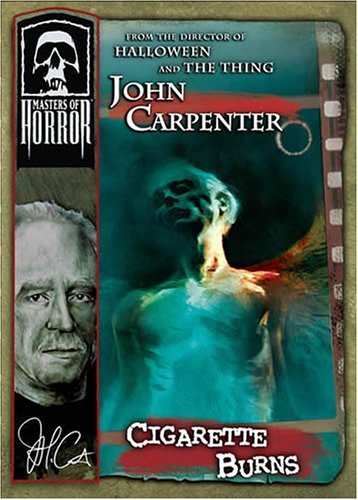 Produced for DVD but initially shown on cable’s
Showtime network, the “Masters of Horror” anthology
recruited a mind-blowing roster of genre veterans to direct episodes
with no boundaries in terms of violence, sex...or, regrettably, poor
scripts.
Produced for DVD but initially shown on cable’s
Showtime network, the “Masters of Horror” anthology
recruited a mind-blowing roster of genre veterans to direct episodes
with no boundaries in terms of violence, sex...or, regrettably, poor
scripts.
Last week Anchor Bay released two episodes from the series on DVD in
excellent, individual presentations with supplements to spare -- Stuart
Gordon’s DREAMS
IN THE WITCH HOUSE (55 mins.) and John Carpenter’s CIGARETTE BURNS (59
mins.), a pair of episodes that show the inherent issues that
plagued most series installments.
Gordon’s “Dreams in the Witch House” is an adaptation
of the H.P. Lovecraft story and offers a fiendish plot augmented by a
healthy dose of gore (including a murdered baby), but the Dennis
Paoli-Stuart Gordon script never really makes you empathize with what
its lead graduate student character (Ezra Godden) is going through.
It’s hackneyed horror like many of Gordon’s bombastic
productions, but if you’re a fan of the latter, you’ll find
“Witch House” to provide a degree of amusement.
Carpenter’s “Cigarette Burns,” meanwhile, is an
original story by Drew McWeeny (better known as Aint It Cool News
correspondent “Moriarty”) and Scott Swan, about a legendary
lost movie that caused its viewers to enter into a homicidal rage, and
one theater programmer’s efforts to track it down. Less
outlandish than Gordon’s effort, “Cigarette Burns”
almost plays like a remake of “The Ninth Gate,” with a
familiar plot off-set by strong direction from Carpenter and music by
Carpenter’s son, Cody, that pays homage to his father’s
efforts. Still, you can’t help but feel a major sense of
“deja vu” as the episode plays itself out.
Despite my mixed thoughts on the episodes (and apparently other entries
in the series by Tobe Hooper among others are far worse!), Anchor Bay
has done a sensational job with the DVDs. Multiple commentaries,
numerous Making Of featurettes, actor and director profiles (including
a superb look at Carpenter’s career), stellar 1.77 (16:9)
transfers and 5.1 Dolby Digital sound make for excellent DVDs that are
also affordable (under $15 in most outlets)...provided you feel the
content is of sufficient interest.
2001 MANIACS
(*½, 2005, 87 mins., R; Lions Gate): Remember back in the
‘80s when you’d routinely see one cheapo, direct-to-video
horror effort after another on the rack of your local video store
haunt? You’d probably hang out with your high school pals and nab
the one with the creepiest or silliest cover, take it home, and then
feel let down that the content wasn’t up to the packaging.
That’s the sort of nostalgic let down you may experience should
you rent this “remake” of Herschell Gordon Lewis’
“Two Thousand Maniacs,” re-christened “2001
Maniacs” and offering the gleeful sight of Robert Englund,
complete with Confederate eyepatch, on the front cover. Alas, little
else in this would-be horror offering is as inspired, with director Tim
Sullivan doing an appropriately lifeless job attempting to juggle the
requisite gore (and there’s a good amount) and comedic
interludes. Lions Gate’s DVD is packed with extras, including two
commentaries, deleted/extended scenes, a Making Of featurette, 5.1
Dolby Digital sound and a decent 1.78 (16:9) transfer. Speaking of the
deleted scenes, what does it tell you that John Landis’ original
opening apparently wasn’t good enough for this movie,
necessitating that the director’s role be re-filmed with an
over-the-top Peter Stomare? Maniacal, to say the least!
New From
Sony
I didn’t think the much-reviled 1998 Emmerich-Devlin version of
GODZILLA would ever see another re-issue on DVD, but that’s the
case this week with Sony’s “Monster Edition” of the
silly but generally mis-understood monster epic.
Yes, I remain one of the few backers of the 1998 “Godzilla”
(***, 139 mins., PG-13), which in no way approximates the good,
clean fun of watching men in rubber suits and listening to hilariously
bad, dubbed dialogue that we all watched growing up on the Creature
Double Feature. Emmerich and Devlin might have failed to deliver on
their intended promises with “Godzilla,” yet the movie is
still entertaining in spots and isn’t nearly as awful as most
kaiju fans would lead you to believe.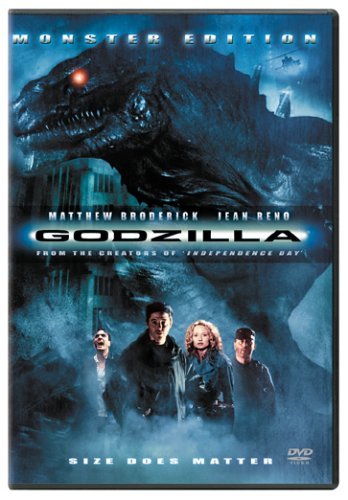
In fact, this tongue-in-cheek sci-fi epic has a lot of good things
going for it: terrific effects and creature design by Patrick
Tatopolous, a rousing score by David Arnold, amusing performances by
Jean Reno and Hark Azaria, and a slam-bang final half-hour with a
dynamite climax on the Brooklyn Bridge. (I’ll even be the first
to admit I felt more for Godzilla’s demise than I did watching
Kong fall from the Empire State at the end of Peter Jackson’s
version!). Sure, there are plenty of things that fail to click, like an
over-abundance of characters played for laughs; a Jurassic
Park-inspired succession of mini-Godzillas; and a D.O.A. female lead
provided by Maria Pitillo, who vanished off the face of the Earth
shortly the movie’s release. That being said, as sheer monster
movie mania goes, the American “Godzilla” is entertaining
in its own way, and worthy of a reevaluation...perhaps if it
didn’t have “Godzilla” in its title the movie
wouldn’t have been scolded the way it was by kaiju fans around
the world.
Sony’s new DVD offers three episodes from the “Animated
Series” spin-off (which continues the story line, this time with
one of the baby-Godzillas, having been raised by the good guys, now
fighting for truth, justice and the American way); a lame “All
Time Best of Godzilla” fight scenes montage that’s
basically just a 10-minute ad for other Sony Godzilla DVDs; and a
production art gallery.
While the DVD reprises most of the supplements from Sony’s
still-solid 1998 original DVD, it leaves off the amusing theatrical
trailers, which contain specially-shot footage not included in the
movie. The 16:9 transfer and 5.1 Dolby Digital sound are still
effective, but there’s little incentive to pick up this package
if you own the original DVD.
Sony has also issued a pair of DVDs from the Godzilla Animated
Series: MONSTER MAYHEM and MUTANT MADNESS, each offering three
episodes from the show (“What Dreams May Come,” “Bird
of Paradise,” and “Deadloch” on “Monster
Mayhem” and “S.C.A.L.E.,” “The Twister,”
and “Where Is Thy Sting” on “Mutant Madness”).
Curiously, two of the episodes (one from each DVD) are among the three
episodes included in the “Monster Edition” of the ‘98
film, with another show (“Monster Wars Part I”) from a
previously released “Animated Series” DVD rounding out that
“special feature.”
NEXT
TIME: NARNIA! Don't
forget
to drop in
on the official Aisle Seat Message
Boards, direct
any emails to the
link
above and
we'll catch you
then. Cheers everyone!

Copyright 1997-2006 All Reviews, Site and Design by Andy
Dursin








 More Aisle Seat Vintage
More Aisle Seat Vintage
 As I wrote earlier, growing up in the ‘80s, I
wasn’t the target audience for night-time soaps like
“Dallas,” “Dynasty,” and KNOTS LANDING,
which last week hit DVD for the first time. However, having checked out
Warner’s new box set (1979-80, 13
episodes, 694 mins.) and recently watched “Desperate
Housewives” copy (but not improve upon) the formula established
by “Knots” for prime-time soap opera fun, I can firmly say
this series is every bit as entertaining as its reputation among fans
would lead you to believe.
As I wrote earlier, growing up in the ‘80s, I
wasn’t the target audience for night-time soaps like
“Dallas,” “Dynasty,” and KNOTS LANDING,
which last week hit DVD for the first time. However, having checked out
Warner’s new box set (1979-80, 13
episodes, 694 mins.) and recently watched “Desperate
Housewives” copy (but not improve upon) the formula established
by “Knots” for prime-time soap opera fun, I can firmly say
this series is every bit as entertaining as its reputation among fans
would lead you to believe. 
 Produced for DVD but initially shown on cable’s
Showtime network, the “Masters of Horror” anthology
recruited a mind-blowing roster of genre veterans to direct episodes
with no boundaries in terms of violence, sex...or, regrettably, poor
scripts.
Produced for DVD but initially shown on cable’s
Showtime network, the “Masters of Horror” anthology
recruited a mind-blowing roster of genre veterans to direct episodes
with no boundaries in terms of violence, sex...or, regrettably, poor
scripts.